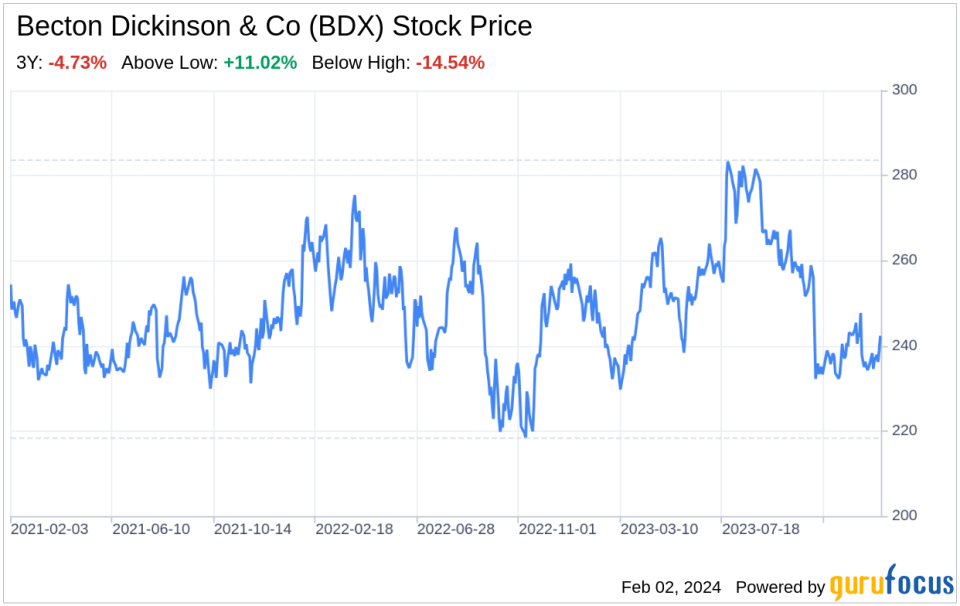Beyond the Balance Sheet: What SWOT Reveals About Becton Dickinson & Co (BDX)
Robust product portfolio and innovation drive BDX's market leadership.
Global presence and diverse revenue streams bolster resilience against market volatility.
Competitive pressures and regulatory challenges present ongoing risks.
Strategic investments and emerging market expansion offer growth opportunities.
On February 1, 2024, Becton Dickinson & Co (NYSE:BDX) filed its 10-Q report, providing a snapshot of the company's financial health and operational performance. As a global leader in medical technology, BDX reported revenues of $4,706 million for the three months ended December 31, 2023, a slight increase from the $4,586 million reported in the previous year. Despite this growth, net income applicable to common shareholders saw a decline from $486 million to $281 million, with diluted earnings per share dropping from $1.70 to $0.96. This financial overview sets the stage for a comprehensive SWOT analysis, offering investors a deeper understanding of BDX's competitive position and strategic direction.

Strengths
Market Leadership and Innovation: Becton Dickinson & Co (NYSE:BDX) stands out for its extensive product portfolio and commitment to innovation. The company's investment in research and development, which amounted to $290 million in the recent quarter, underscores its focus on maintaining a pipeline of cutting-edge medical technologies. BDX's strong brand is supported by its history of delivering reliable medical supplies and devices, which has cultivated a loyal customer base in the healthcare industry.
Financial Resilience: BDX's financial statements reveal a robust balance sheet, with a diverse revenue stream that includes significant international sales, accounting for 43% of its business. This global footprint helps mitigate the impact of regional economic fluctuations and provides a buffer against market volatility. The company's ability to maintain a steady revenue stream, despite macroeconomic challenges, is a testament to its financial resilience.
Weaknesses
Profitability Pressures: The recent decline in net income and earnings per share indicates pressure on BDX's profitability. Factors contributing to this include increased cost of products sold, which rose from $2,453 million to $2,679 million, and higher selling and administrative expenses. These financial pressures highlight the need for BDX to enhance operational efficiency and manage costs more effectively to improve its bottom line.
Regulatory and Legal Challenges: BDX operates in a highly regulated industry, and the company's SEC filings point to ongoing regulatory matters, such as the FDA Warning Letter related to quality system regulations. Compliance with stringent regulations and the potential for legal disputes can lead to increased costs and operational disruptions, which could weaken BDX's competitive edge if not managed properly.
Opportunities
Emerging Market Expansion: BDX's strategic focus on expanding into emerging markets presents significant growth opportunities. The company's efforts to penetrate regions such as Eastern Europe, the Middle East, Africa, and parts of Asia could lead to increased sales and market share, as healthcare infrastructure in these areas continues to develop and demand for medical technology rises.
Strategic Acquisitions: BDX's history of strategic acquisitions, such as the integration of CareFusion, has bolstered its product offerings and market presence. The company's ability to identify and successfully integrate complementary businesses could further enhance its competitive position and drive long-term growth.
Threats
Competitive Landscape: BDX faces intense competition from other medical technology firms, which could impact its market share and pricing power. The company's SEC filing acknowledges the challenges posed by volume-based procurement programs, particularly in China, which have adversely affected operations. Staying ahead of competitors will require continuous innovation and strategic pricing models.
Macroeconomic Factors: Global macroeconomic factors, such as labor shortages and elevated costs, as well as logistics capacity constraints, have the potential to disrupt BDX's supply chain and increase operational expenses. The company must navigate these challenges to maintain its production efficiency and cost competitiveness.
In conclusion, Becton Dickinson & Co (NYSE:BDX) exhibits a strong market position, bolstered by its innovative product portfolio and global presence. However, the company must address profitability pressures and regulatory challenges to sustain its competitive advantage. Opportunities for growth through emerging market expansion and strategic acquisitions are promising, but BDX must remain vigilant against competitive threats and macroeconomic uncertainties. By leveraging its strengths and addressing its weaknesses, BDX can capitalize on opportunities and mitigate threats, positioning itself for continued success in the dynamic medical technology industry.
This article, generated by GuruFocus, is designed to provide general insights and is not tailored financial advice. Our commentary is rooted in historical data and analyst projections, utilizing an impartial methodology, and is not intended to serve as specific investment guidance. It does not formulate a recommendation to purchase or divest any stock and does not consider individual investment objectives or financial circumstances. Our objective is to deliver long-term, fundamental data-driven analysis. Be aware that our analysis might not incorporate the most recent, price-sensitive company announcements or qualitative information. GuruFocus holds no position in the stocks mentioned herein.
This article first appeared on GuruFocus.
